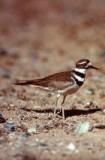It’s On the Ground! It’s in the Air! It’s a Killdeer!
By Kristi Butler
What is a killdeer?
It is one cool bird.
Where on earth did it get that name?
Other people wondered that, too. Most likely it comes from its call — a high, drawn out “Keeee” or Kill-dee.”
Does it actually kill deer?
No way! It makes the call to communicate with other killdeer and with people.
The killdeer doesn’t nest in trees. They lay their eggs right on the ground. Sometimes they are in the “natural areas” of your yard, like in wood chips or pine straw. You might even find them in the middle of a cow pasture, a golf course, a ball field, the gravel beside a railroad track or even in the rocks of a parking lot! Because they are level with the ground and the eggs look like speckled stones, they seem to blend in and are often difficult to spot. That’s some cool God-made camouflage.
Both killdeer parents take part in the nesting and incubation. The male hollows out the nest. He squats and moves in a circling motion, scratching with his feet until it is just right. As soon as the female has laid all four eggs, the parents begin sitting on them. It takes twenty-four to twenty-eight days before the chicks hatch. During this time, mom and dad take turns with “sitting” duty and “lookout” duty. Since the eggs are out in the open, the killdeer has a clear view of any threatening predators. If someone comes near the nest, the parent that is sitting slowly rises and starts walking away. Its call seems to say, “Leave, leave…go, go, go!”
Get ready for some drama. The bird fakes a broken wing. It’s an acting job worthy of some great bird award. He draws your attention. You want to help. As you get close, he runs a little further and puts on the show again, sometimes with both wings dragging pitifully. You can almost reach out and pick him up. Mission accomplished! You are away from the nest. He sings his victory song, “KILL-DEE!” and flies back to his “post.”
By the way, killdeer are also known to do a little “dive-bombing.” An adult bird will stretch out its wings and fly directly at intruders, such as a grazing cow, dogs, foxes and sometimes even people.
In case you discover a nest and want to see the babies, stay alert. They won’t be there long. Killdeer are precocious birds. That means they can walk around and feed themselves shortly after hatching. As soon as their down dries (about an hour or so), they leave the area for a safe brooding place in taller grass or nearby bushes. That very day, they scurry around jabbing at the ground in search of food. They eat insects, such as weevils, grasshoppers, ticks, mosquitoes, flies, ants and worms.
Even though the chicks can feed themselves, the parents stay close for protection. At the first sign of danger, they sound an alarm note that warns the chicks to freeze. The babies squat and don’t move a muscle until the signal is given that all is well.
For the first few days, the chicks are covered with their parent’s wings often for short naps, at night and to be protected from the heat or cold. They stay with them until they fledge (grow feathers they need for flight). This takes about a month. Then they are on their own.





